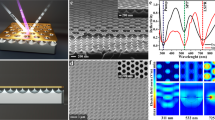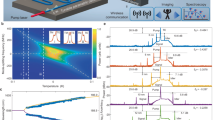Abstract
The ability to tune the frequency of an oscillator is of critical importance and is a fundamental building block for many systems, be they mechanical or electronic1,2. However, this very important function is still highly inadequate in optical oscillators, particularly in semiconductor laser diodes3,4. The limitations in tuning a laser frequency (or wavelength) include the tuning range and the speed of tuning, which is typically milliseconds or slower. In addition, the tuning is often not continuous and may require complex synchronization of several electrical control signals. In this Letter, we present a new tunable laser structure with a lightweight nanoelectromechanical mirror based on a single-layer, high-contrast subwavelength grating. The high-contrast subwavelength grating reflector enables a drastic reduction of the mirror mass, which increases the mechanical resonant frequency and hence tuning speed5. This allows for a wavelength-tunable light source with potential switching speeds of the order of tens of nanoseconds and suggests various new areas of practical application, such as bio- or chemical sensing6,7,8, chip-scale atomic clocks9 and projection displays10,11.
This is a preview of subscription content, access via your institution
Access options
Subscribe to this journal
Receive 12 print issues and online access
$209.00 per year
only $17.42 per issue
Buy this article
- Purchase on Springer Link
- Instant access to full article PDF
Prices may be subject to local taxes which are calculated during checkout





Similar content being viewed by others
References
Horowitz, P. & Hill, W. The Art of Electronics (Cambridge Univ. Press, New York, 1980).
Ilic, B. R., Krylov, S., Kondratovich, M. & Craighead, H. G. Optically actuated nanoelectromechanical oscillators. IEEE J. Sel. Top. Quant. Electron. 13, 392–399 (2007).
Bruce, E. Tunable lasers. IEEE Spectrum 39, 35–39 (2002).
Coldren, L. A. Monolithic tunable diode lasers. IEEE J. Sel. Top. Quant. Electron. 6, 988–999 (2000).
Craighead, H. G. Nanoelectromechanical systems. Science 290, 1532–1535 (2000).
Li, M., Tang, H. X. & Roukes, M. L. Ultra-sensitive NEMS-based cantilevers for sensing, scanned probe and very high-frequency applications. Nature Nanotech. 2, 114–120 (2007).
Cooper, M. A. Optical biosensors in drug discovery. Nature Rev. Drug Discov. 1, 515–528 (2002).
Lackner, M. et al. CO and CO2 spectroscopy using a 60 nm broadband tunable MEMS-VCSEL at 1.55 µm. Opt. Lett. 31, 3170–3172 (2006).
Knappe, S. et al. A chip-scale atomic clock based on 87Rb with improved frequency stability. Opt. Express 13, 1249–1253 (2005).
Van Kessel, P. F., Hornbeck, L. J., Meier, R. E. & Douglass, M. R. A MEMS-based projection display. Proc. IEEE 86, 1687–1704 (1998).
Solgaard, O., Sandejas, F. S. A. & Bloom, D. M. Deformable grating optical modulator. Opt. Lett. 17, 688–690 (1992).
Wu, M. C., Solgaard, O. & Ford, J. E. Optical MEMS for lightwave communication. J. Lightwave Technol. 24, 4433–4454 (2006).
Iga, K. Surface-emitting laser — its birth and generation of new optoelectronics field. IEEE J. Sel. Top. Quant. Electron. 6, 1201–1215 (2000).
Koyama, F. Recent advances of VCSEL photonics. J. Lightwave Technol. 24, 4502–4513 (2006).
Chang-Hasnain, C. J. Tunable VCSEL. IEEE J. Sel. Top. Quant. Electron. 6, 978–987 (2000).
Harris, J. S. Jr. Tunable long-wavelength vertical-cavity lasers: The engine of next generation optical networks? IEEE J. Sel. Top. Quant. Electron. 6, 1145–1160 (2000).
Riemenschneider, F. et al. Continuously tunable long-wavelength MEMS-VCSEL with over 40-nm tuning range. IEEE Photon. Technol. Lett. 16, 2212–2214 (2004).
Hofmann, W. et al. High speed (>11 GHz) modulation of BCB-passivated 1.55 µm InGaAlAs–InP VCSELs. Electron. Lett. 42, 976–977 (2006).
Huang, M. C. Y., Zhou, Y. & Chang-Hasnain, C. J. A surface-emitting laser incorporating a high-index-contrast subwavelength grating. Nature Photon. 1, 119–122 (2007).
Huang, M. C. Y., Zhou, Y. & Chang-Hasnain, C. J. Nano electro-mechanical optoelectronic tunable VCSEL. Opt. Express 15, 1222–1227 (2007).
Mateus, C. F. R., Huang, M. C. Y., Deng, Y., Neureuther, A. R. & Chang-Hasnain, C. J. Ultrabroadband mirror using low-index cladded subwavelength grating. IEEE Photon. Technol. Lett. 16, 518–520 (2004).
Mateus, C. F. R., Huang, M. C. Y., Chen, L., Chang-Hasnain, C. J. & Suzuki, Y. Broad-band mirror (1.12–1.62 µm) using a subwavelength grating. IEEE Photon. Technol. Lett. 16, 1676–1678 (2004).
Huang, M. C. Y., Cheng, K. B., Zhou, Y., Pisano, A. P. & Chang-Hasnain, C. J. Monolithic integrated piezoelectric MEMS-tunable VCSEL. IEEE J. Sel. Top. Quant. Electron. 13, 374–380 (2007).
Bendickson, J. M., Glytsis, E. N., Gaylord, T. K. & Brundrett, D. L. Guided-mode resonant subwavelength gratings: Effects of finite beams and finite gratings. J. Opt. Soc. Am. A 18, 1912–1928 (2001).
Maute, M. et al. Long-wavelength tunable vertical-cavity surface-emitting lasers and the influence of coupled cavities. Opt. Express 13, 8008–8014 (2005).
Mateus, C. F. R., Huang, M. C. Y. & Chang-Hasnain, C. J. Micromechanical tunable optical filters: General design rules for wavelengths from near-IR up to 10 µm. Sens. Actuat. A 119, 57–62 (2005).
Ding, Y. & Magnusson, R. Resonant leaky-mode spectral-band engineering and device applications. Opt. Express 12, 5661–5674 (2004).
Boutami, S., Benbakir, B., Leclercq, J. L. & Viktorovitch, P. Compact and polarization controlled 1.55 µm vertical-cavity surface-emitting laser using single-layer photonic crystal mirror. Appl. Phys. Lett. 91, 071105 (2007).
Gustavsson, J. S. et al. Efficient and individually controllable mechanisms for mode and polarization selection in VCSELs, based on a common, localized, sub-wavelength surface grating. Opt. Express 13, 6626–6634 (2005).
Acknowledgements
This project was supported by the Defense Advanced Research Projects Agency (DARPA) Center for Optoelectronic Nanostructure Semiconductor Research and Technology (CONSRT). We thank Land Mark Optoelectronic for the growth of the epitaxy wafer and Berkeley Microfabrication Laboratory for the fabrication support.
Author information
Authors and Affiliations
Corresponding author
Rights and permissions
About this article
Cite this article
Huang, M., Zhou, Y. & Chang-Hasnain, C. A nanoelectromechanical tunable laser. Nature Photon 2, 180–184 (2008). https://doi.org/10.1038/nphoton.2008.3
Received:
Accepted:
Published:
Issue Date:
DOI: https://doi.org/10.1038/nphoton.2008.3
This article is cited by
-
Active optomechanics
Communications Physics (2022)
-
Continuous-wave upconversion lasing with a sub-10 W cm−2 threshold enabled by atomic disorder in the host matrix
Nature Communications (2021)
-
A wavelength-size tunable Fabry–Pérot laser
Nature Photonics (2019)
-
Electromagnetic field quantization and quantum optical input-output relation for grating
Scientific Reports (2019)
-
Broadband continuous single-mode tuning of a short-cavity quantum-cascade VECSEL
Nature Photonics (2019)



